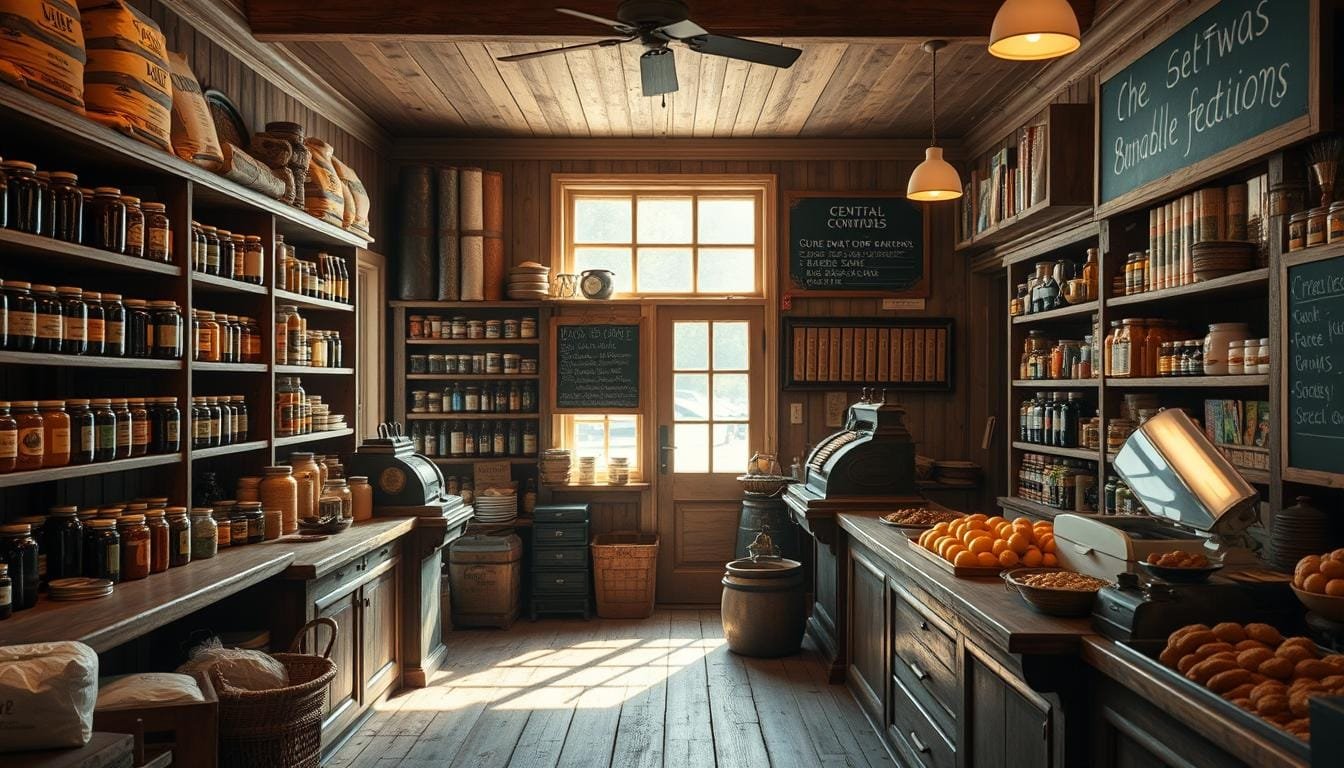USA food markets are full of different foods, from old general stores to new supermarkets. They are key in the food retail world. They offer fresh produce, handmade items, and local treats. Let’s look at the wide range of traditional food markets in America.
Grocery stores and supermarkets are big in the USA. But, for real flavors and special shopping, traditional markets are the best. They have old places and busy food halls for everyone.
Did you know there are over 100 food halls in the USA? These new markets are getting more popular. For example, Chelsea Market in New York is famous worldwide. Reading Terminal Market in Philadelphia has been open since 1893, showing the lasting charm of traditional markets.
USA food markets show the country’s varied food culture. The West Side Market in Cleveland, Ohio, is the oldest public market, since 1912. On the West Coast, Grand Central Market in Los Angeles has been a favorite since 1917. These markets not only sell food but also keep local traditions alive for future generations.
Traditional General Stores: America’s Historic Food Markets

Step into a slice of American history at traditional general stores. These charming places are both food markets and community centers. They offer a unique shopping experience that reminds us of simpler times.
Historic General Stores Still Operating Today
Many historic general stores still thrive across the USA. The Brick Store in Bath, New Hampshire, is the longest-running general store in the U.S. Rabbit Hash General Store in Kentucky, started in 1831, has survived floods and fires.
In Alaska, Nagley’s General Store has been around since 1921. It’s a key food distribution center for the local community.
Regional Food Specialties in General Stores
These stores often highlight regional delicacies. The End of the Commons General Store in Ohio, open since 1840, is famous for Amish fry pies. Zeb’s General Store in New Hampshire has over 5,000 products, many locally made.
The Cazadero General Store in California offers artisanal groceries and local wines. It acts as a mini food wholesale market.
Community Gathering Places and Food Heritage
General stores are more than just food markets; they’re community centers. The Hope General Store in Maine, open since 1832, sells local produce and makes sandwiches to order. Yoho General Store in Indiana is also a local restaurant, hosting events all year.
These places keep America’s food heritage alive. They connect the past and present by bringing people together to share meals.
USA Food Markets: Modern Shopping Destinations
The USA’s food scene is changing fast. Modern markets offer new tastes, support local farmers, and improve food chains.
Public Markets and Food Halls
Food halls are all the rage in America. Over 100 of them are now across the country. Each one brings something special to the table.
The Ferry Building Marketplace in San Francisco is a big deal. It has farmers markets, bakers, and wine sellers. Faneuil Hall in Boston is even bigger, with over 100 places to eat.
Farmer’s Markets and Local Food Distribution
Farmer’s markets are key for local food. They let people buy fresh, seasonal food straight from farmers. The West Side Market in Cleveland is a historic gem.
It has 100 stalls with different food vendors. These markets help local farmers and improve food chains.
Specialty Food Retailers and Ethnic Markets
Specialty stores meet specific tastes. Russ & Daughters in New York has been around for a century. It opened a new spot in Brooklyn in 2018.
Places like Latinicity Food Hall in Chicago show off different foods. It has eight kitchens serving Latin street food.
| Food Market | Location | Notable Feature |
|---|---|---|
| Ferry Building Marketplace | San Francisco, CA | Farmers markets, bakers, wine merchants |
| West Side Market | Cleveland, OH | 100 stalls, diverse food vendors |
| Latinicity Food Hall | Chicago, IL | 8 kitchens, Latin street foods |
| Russ & Daughters | Brooklyn, NY | Century-old institution, expanded in 2018 |
Conclusion
The USA food markets show a colorful picture of the nation’s food scene. From old general stores to new food halls, there’s a wide range of food experiences. In 2023, the food retail industry reached new heights, with foodservice adding $1.5 trillion to the economy.
Full-service and limited-service places were the biggest, making over $1 trillion together. This shows more people are eating out, with each person spending $3,923 on food away from home. Washington, DC, Nevada, and Hawaii were the top, with sales 30% higher than California.
The packaged food market is also huge. Worth $1030.9 billion in 2022, it’s expected to grow to $1572.06 billion by 2031. Bakery products are leading this growth, thanks to people wanting healthier, easier food options. This change in the food market shows Americans’ shifting tastes and values.
But, there’s a big problem: food waste. Up to 40% of all food in the US is thrown away each year, costing nearly $165 billion. This waste also harms the environment, with a carbon footprint of 3.3 billion tons of CO2 yearly. As we celebrate the USA’s food markets, we must tackle this waste for a greener food future.



